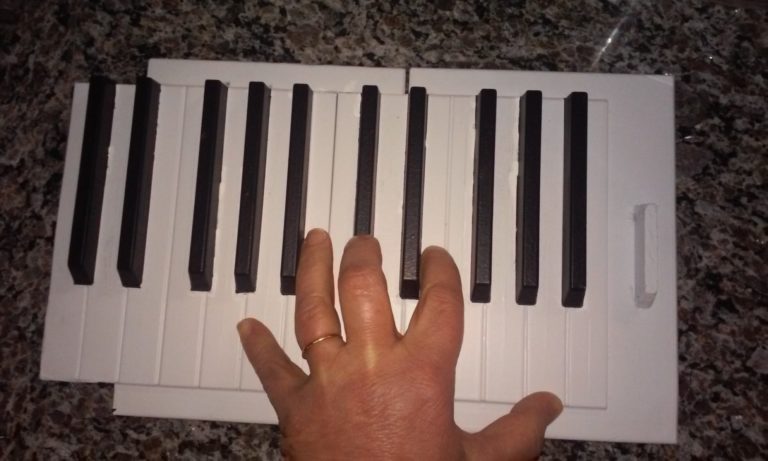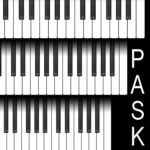PASK YouTube channel
The PASK YouTube channel has 12 playlists:- https://www.youtube.com/channel/UCdiQ0iwCWFsGjZ1QI41KSBg/playlists:
- Alternatively Sized Keyboards in Action
- PASK Videos
- Media Stories and vlogs
- Piano Industry & Teacher Videos
- Personal Stories and First Try-outs
- Comparing keyboards and interchanging actions
- DS Standard Foundation
- International Stretto Piano Festival – 2021
- International Stretto Piano Festival – 2022
- International Stretto Piano Festival – 2023
- Change of Keys CD – Carol Leone
- Shorts
Contributions to this channel are welcome – they can be excerpts (comparisons of a pianist playing the same excerpt using the conventional and a stretto keyboard are particularly useful where the difference is apparent) or complete performances by professional or amateur pianists of any age on a keyboard with narrower keys. If you have a movie to contribute, please be in contact via: info@paskpiano.org
PASK handouts
The following PASK handouts are available for download here:
- Summary for Pianists and Teachers: https://paskpiano.org/wp-content/uploads/2022/05/PASK-Pianist-Teacher-Hand-out-May-2022.pdf
- An Opportunity for the Piano Industry: https://paskpiano.org/wp-content/uploads/2021/09/PASK-Piano-industry-hand-out-_September-2021.pdf
- Also available in Japanese: https://paskpiano.org/wp-content/uploads/2019/03/Japanese-version-PASK-Piano-industry-hand-out-_Oct-2015-hs.pdf
- One-page summary for industry: https://paskpiano.org/wp-content/uploads/2021/09/PASK-Industry-one-pager_September-2021.pdf
- Summary for the Media: https://paskpiano.org/wp-content/uploads/2022/05/PASK-Media-summary-May-2022.pdf
- Quotes and personal stories: https://paskpiano.org/wp-content/uploads/2024/08/PASK-Quotes-and-stories_August-2024.pdf
- Common objections or questions and suggested responses: https://paskpiano.org/wp-content/uploads/2021/09/PASK-Common-objections-and-responses_September-2021.pdf
- Links and QR codes for relevant websites:https://paskpiano.org/wp-content/uploads/2024/04/Relevant-websites-and-QR-codes_-April-2024.pdf
- A bibliography is available here: https://paskpiano.org/wp-content/uploads/2022/10/Alternatively-sized-piano-keyboards-Bibliography_Sept-2022.pdf
Posters
A poster (A0 size) presented at the EPTA conference in Reykjavik in 2016 can be downloaded here: https://paskpiano.org/wp-content/uploads/2019/03/EPTA-poster_2016.pdf
A smaller poster (A1 size) can be downloaded here. This version was created in December 2023. https://paskpiano.org/wp-content/uploads/2023/12/Small-poster-A1-Dec-2023.pdf
DS Standard Foundation
In 2018 the Steinbuhler company, the major manufacturer of alternatively sized keyboards, was converted into a non-profit Foundation in the State of Pennsylvania, USA, and has been awarded 501(c)(3) status.
The Mission of the Foundation is to set a standard for alternatively sized keyboards that is recognized globally so that pianists, whether amateurs or professionals, may achieve their full musical potential while avoiding injury and perform with confidence anywhere in the world, knowing that a keyboard bearing the DS logo will be the size with which they are familiar.
A major strategy for the Foundation is to loan DS keyboards to universities or music schools around the world for a period of 12 months, after which the institution has the option of purchase. Hailun HU1P upright pianos are also available for loan. See these testimonials from American universities who own, or have borrowed, DS keyboards for their pianos. https://paskpiano.org/wp-content/uploads/2020/03/Keyboard-School-Testimonies.pdf
To learn more about how the Foundation may assist educational institutions, pianists and manufacturers around the world, or to donate towards this cause, please visit the website: http://dsstandardfoundation.org/. On Facebook: https://www.facebook.com/dsstandardfoundation/
3D models of keyboards
A physical model of the piano keyboard that can be touched and felt can be far more convincing than logical arguments and data sets on a page or screen. These can be made quite cheaply by anyone with access to a 3D printer. Note the ‘Goliath’ size (7.6 inch, or 19.2 cm octave) is useful to show a large-handed pianist so they can experience what it feels like to have small hands!
Keyboards are made in pieces, each covering one C to B note section. They hook together to make as wide a keyboard as you would like. To the right you can see a woman with an average female hand span “playing” an A Major octave chord (A-C#-E-A) on a 5.5-size keyboard.
If you would like to have your own set of plastic keyboards for demonstration, just download the files below and take them to a local 3D print shop in your area. A two-octave range should be sufficient. A US printer who has printed a number of these has provided the following tips on printing the files.

1.) Printing was done with PLA plastic, a low cost material used for printing prototypes. Printer resolution was 0.2 mm. Printing with a resolution of 0.1 mm will give a nicer model, but printing will take at least twice as long and will cost you twice as much.
2.) Surface imperfections will happen. They can be removed with sandpaper or acetone (which slightly dissolves the plastic). There are videos available online describing how to use acetone to improve a 3D printed figure.
3.) 3D printing melts the plastic and then lets it set to re-harden. Minor faults can be bent back into place after softening the material with a heat gun.
4.) The keyboard files should be printed with a support under keys C and D. A good 3D print shop will know how to do this.
The 5.5 inch (141 mm) octave size model: https://paskpiano.org/wp-content/uploads/2022/10/Keyboard-5.5-inch138mm.stl_-1.zip
The 6.0 inch (152 mm) octave size model: https://paskpiano.org/wp-content/uploads/2022/10/Keyboard-6.0-inch151mm.stl_-1.zip
The 6.5 inch (165 mm) octave size conventional keyboard model: https://paskpiano.org/wp-content/uploads/2022/10/Keyboard-6.5-inch161mm.stl_-1.zip
The 7.6 inch (192 mm) octave size ‘Goliath’ keyboard model: https://paskpiano.org/wp-content/uploads/2022/10/Keyboard-7.6-inch188mm.stl_-1.zip
7.6 Inch Octaves: Take the Goliath Challenge
The 7.6 is a keyboard size we call ‘Goliath’. If you play the conventional piano keyboard with perfect comfort, you can experience what smaller-handed pianists cope with by placing your hands on this keyboard. Position your hand for a 4-note octave chord or a wide interval and pay attention to the strain in your hand.
The average man’s hand span is one inch wider than the average woman’s hand span. This keyboard gives men the experience that women (in general) have at the piano. Remember that young children’s hands are even smaller and often under even more strain.
Linda Gould took a model of the 5.5 size keyboard to NAMM (the National Association of Music Merchants annual show) in 2019 and spoke to piano manufacturers about the benefits of this new standard.
Here are Linda’s reflections on the response she had at NAMM:
- “I was listening to a performance on a digital keyboard at NAMM and noticed the performer could barely reach an octave even though she was a professional (she sang and accompanied herself and was fabulous!) I spoke with her afterward and asked, “if she could perform on a narrower keyboard that fit her hand, and enabled her to reach octaves and even 10ths easily, would she want one?” She replied with a firm NO. “Why?”, I asked. “Because I worked hard to create ‘workarounds’ that enabled me to play what my hand can handle.” At this point I pulled the plastic 3D 5.5″ keys out of my bag and asked her to ‘play’ an A major chord on it (there was no sound, she could only feel it). She was amazed and did a complete about-face. She asked me if such a keyboard was being made and could she get one as soon as possible? Then she motioned to her agent to come over and give me her business card so she will know the minute one is available.”
- “I met other women at NAMM who played piano, and every one of them took the PASK info after they tried the 3D keys. It was quite inspiring. Something about playing on silent keys allowed them to concentrate and appreciate the FEEL of the keys without sound clouding the experience.”
- ” Everywhere I looked in the acres of instruments at the Anaheim convention centre, there were small violins, small guitars, small ukeleles, small cellos, small drums etc. etc. and when I asked about narrow or small keyboards many in the industry said, “I never thought of that. That could be a good idea.” They even showed toy pianos that had regular sized large keys!! The rest of the music industry acknowledges that children or adults with smaller hands need an appropriate sized instrument. We need to break through the glass wall that says all piano keys must be the same size. So many professional piano players bring their own digital keyboards to gigs, why can’t they have the right size?
If you need further advice, you may like to contact Kathy Strauch: taskpiano@gmail.com
Another option for 3D printing is to order your own from this 3D print shop in the US. They can make all of the above sizes (5.5, 6.0, 6.5, 7.6) PLUS the 5.1 size!
https://www.etsy.com/listing/1624900872/pask-piano-model?fbclid=IwAR1sLDOI4S1wyTAM0FK3oz6zJRVhSN_9Rh9UIEcnYnmrS-GZpT67QA4QiNU
Other websites, blogs and recordings
The webpage of HMDK (University of Music and Performing Arts) Stuttgart about their Sirius 6.0 pianos and events: https://www.hmdk-stuttgart.de/facilities/sirius-60/?L=1
Dr Carol Leone from Dallas, Texas – Chair of Keyboard Studies at SMU Meadows School of the Arts in Dallas, internationally recognized performing artist, teacher, lecturer, and author, and one of the world’s leading researchers and proponents of alternatively sized piano keyboards to promote a pianist’s wellness: www.carolleone.com
Sydney teacher and Suzuki teacher trainer, Erica Booker, has pianos with alternatively sized keyboards in her studio. https://ericabookerpiano.com/
Co-inventor of DS® keyboards with David Steinbuhler, Canadian pianist Chris Donison: http://chrisdonison.com/keyboard.html
Stretto Piano concerts website: https://www.strettopianoconcerts.org/
Canadian pianist and teacher, Linda Gould, was the first customer for a DS5.5® keyboard: https://www.playpianochordstoday.com/narrow
The website of a Japanese pianist who owns an upright piano with DS5.5® keyboard: https://musil0723.sakura.ne.jp/dufyfan/
About past attempts to gain support for narrower keyboards in Japan: http://littlehands782.blogspot.jp/2014/01/the-history-and-attitudes-to-smaller.html/
Concert pianist Kathryn Mientka performs regularly on a DS5.5® keyboard in Arizona. http://www.kathrynmientka.com/
Pianist Tiffany Goff, from Cleveland Ohio, has a blog: www.skinnykeys.tumblr.com
Pianist Josh Lee from California, who purchased a Walter upright piano with DS5.5®) keyboard: https://www.joshlee.com/blog/right-size-pianos/
Pianist Grace Choi has written this personal story:- Thoughts for Pianists with Small Hands: A Testimonial by Grace Choi. It is the second blog on this page: http://www.thehealthymusicianproject.com/blog
Pianist and teacher Eliana Yi, from Seattle, is a graduate of Southern Methodist University in Dallas, where she benefited from performing on DS®) keyboards. https://www.elianayipianostudio.com/alternative-keyboards
From Jess Johnson, Professor of Piano and Piano Pedagogy at the University of Madison-Wisconsin, where there is a DS5.5® keyboard installed. http://feelingthesound.org/2015/07/21/small-hands-big-heart/
Also see Jess’s recital at this university in February 2016, including works by Schumann and Schubert: https://www.youtube.com/channel/UCaGxRNaz3pHC-DaVDwvwuqw
A group of academics in Germany and Switzerland is continuing with important research of the late Dr Christoph Wagner relating to the hands of pianists and violinists. Three websites describe this work: http://www.hand-und-instrument.de/E_index.html; http://www.hand-und-instrument.de/E_pragm-handeinschaetzung.html; http://www.christoph-wagner-musikphysiologie.de/Links.html. For further information, contact Professor Ulrike Wohlwender from the University of Music and the Performing Arts in Stuttgart: u.wohlwender@online.de. See http://smallpianokeyboards.org/earlier-studies/ for some of Wagner’s summary statistics.
Dr Carol Leone’s CD: Change of Keys: One Piano, Three Keyboards, featuring works by Hayden, Beethoven, Chopin, Liszt, Debussy and Bartok, was released in 2016. Her CD won silver medals for outstanding achievement in both the Classical and Solo Instrumental categories in the Global Music Awards 2016. For four excellent reviews, go to:- http://classicalmodernmusic.blogspot.com.au/2016/09/carol-leone-change-of-keys-one-piano.html?m=1 and http://transcentury.blogspot.com.au/2016/11/soloistic-thinking-and-rethinking.html and http://theclassicalreviewer.blogspot.co.uk/2016/11/carol-leone-uses-three-donison.html?m=1, and download the review from the American Record Guide (Jan/Feb 2017) here: https://paskpiano.org/wp-content/uploads/2019/03/American-Record-Guide-Review.pdf
You can order the CD here:- http://www.msrcd.com/catalog/cd/MS1616.
Professor Jess Johnson (University of Wisconsin-Madison) has released a CD of new works performed on a DS5.5® keyboard. https://jessjohnsonpiano.com/sojourn-new-album-release
Recent and useful publications
Chi, J-Y., Halaki, M., Booker, E., Boyle, R. & Ackermann, B.J. (2021). Interaction between Hand Span and Different Sizes of Keyboards on EMG Activity in Pianists: An Observational Study. Applied Ergonomics, 97, November.
Perez, Caroline Criado. (2019). Invisible Women: Data Bias in a World Designed for Men. Penguin, London. (pp 157-159.)
Son, Y.J. (2018). Assessing Perception and Attitude of Pianists toward Ergonomically Scaled Piano Keyboards (ESPK): Raising Awareness about ESPK and Evaluating Changes of Attitude through an Educational Survey. DMA dissertation, University of North Texas. https://digital.library.unt.edu/ark:/67531/metadc1248515/?fbclid=IwAR14ad2V9zvuZZZS5x9ZaN8ossosasT95Ts0UVZi3GK8kP8jh1C0nUiJ1nQ
Coates, S. (2017). Goldilocks and the Three Pianos – Ergonomics in Pianists. The Piano Teacher, November, Hal Leonard Australia. Copy here: https://paskpiano.org/wp-content/uploads/2021/09/Goldilocks-and-the-Three-Pianos-Ergonomics-in-pianists-The-Piano-Teacher.pdf
Deahl, L. & Wristen, B. (2017). Adaptive Strategies for Small-Handed Pianists, Oxford University Press.
Leone, C. (2017). Personal Touch. International Piano, UK, January-February 2017. http://www.carolleone.com/ergonomic-keyboards/
Professor Carol Leone’s answers to common questions: https://pianoinspires.com/alternatively-sized-keyboards-special-guest-qa-with-expert-carol-leone/
Boyle, R., Boyle, R. & Booker, E. (2017). Narrower Keyboards for Larger Hands. Readers’ Letters, Pianist. UK, January. Copy here: https://paskpiano.org/wp-content/uploads/2021/09/Letter-to-Pianist-magazine_Jan-2017.pdf
Leone, C. (2015). Ergonomic Keyboards: Size does Matter. Piano Professional, EPTA (UK), Summer. http://www.carolleone.com/ergonomic-keyboards/
Leone, C. (2015). Size is Key. Clavier Companion, Frances Clark Center for Keyboard Pedagogy, USA , September/October. http://www.carolleone.com/ergonomic-keyboards/. You will also find a copy of the editorial here: https://paskpiano.org/wp-content/uploads/2021/09/clavier_companion_editorial_Sept-Oct-2015.pdf
Boyle, R., Boyle, R. & Booker, E. (2015). Pianist Hand Spans: Gender and Ethnic Differences and Implications for Piano Playing, Proceedings of the 12th Australasian Piano Pedagogy Conference, Beyond the Black and White, Melbourne, July 2015. (https://www.appca.com.au/proceedings/)
Hand span data analysis – Statistics Summary, 2015. https://paskpiano.org/wp-content/uploads/2021/09/NCKP-Hand-span-data-Statistics-Summary-2015.pdf
Boyle, R. (2012). The experience of playing reduced-size piano keyboards. A survey of pianists. MTNA e-Journal, April.
McLachlan, M. (2010), Editorial, Piano Professional, EPTA (UK), Spring. https://paskpiano.org/wp-content/uploads/2021/09/EditorialContents_Piano-Professional-UK_Spring-2010.pdf
Boyle, R & Boyle, R. (2010). Hand size and the piano keyboard. An introduction to the technical and musical benefits for pianists using reduced-size keyboards. Piano Professional, EPTA (UK), Spring, 18-23.
For technical articles about piano design, go to the page: https://paskpiano.org/manufacturers/
Getting involved
Here are some of the ways that you can be actively engaged. Much of the information needed is on this website and other websites, for example: http://dsstandardfoundation.org
1. Spread awareness of the benefits of piano keyboards with narrower keys and the problems with the current ‘one-size-fits-all’ large keyboard by:-
- Writing articles for journals, classical music and mainstream media
- Giving presentations to piano teachers, academics and performing arts health professionals at conferences and seminars
- Actively using blogs and social media
- Keeping abreast of the latest research and sharing this informing with others
- If you are a piano teacher acquiring a keyboard with narrower keys, encouraging parents/students to follow suit.
2. Help expand availability of alternatively sized keyboards so that pianists can experience narrower keys by:-
- Lobbying piano manufacturers and retailers, universities, schools and organisers of piano competitions
- Setting up new piano competitions or encouraging existing ones to provide keyboard choice, and ensuring these competitions are well publicized
- Assisting universities and schools raise funds to provide these keyboards for students and for research – for example, running a fund-raising ‘marathon’ concert involving all piano students at the school or university!
- Encouraging and helping organize public recitals featuring alternatively sized keyboards
- Identifying potential sponsors or sources of funds for, and worthy recipients (including universities, schools, concert venues) of ESPKs. Please be in touch via the email below if you are keen to donate (or know of other potential sponsors) and would like help in identifying recipients who are committed to change.
- Identifying potential sponsors to increase prize money at competitions that provide keyboard choice.
- Investing in new projects relating to the manufacture of alternatively sized keyboards. Please be in touch by email and we will direct you to projects that may need funding.
3. Help break down barriers and resistance to change by:-
- Working to change discriminatory examination policies
- Encouraging well-known pianists, teachers and academics to become ‘champions’ of the cause
- Actively countering unhelpful attitudes and misconceptions through use of the media, talks to piano teachers, etc.
———————————————–
Please email info@paskpiano.org if you would like to be directly involved or receive email updates from time to time.
If you are on Facebook, this is the PASK site: www.facebook.com/pask.piano
You may wish to join the closed group on Facebook: https://www.facebook.com/groups/PASK.Action/
You can also show your support for the DS Standard Foundation Facebook page: https://www.facebook.com/dsstandardfoundation/ and the International Stretto Piano Festival Facebook page: https://www.facebook.com/strettofestival


